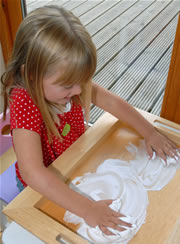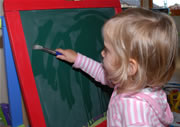Developing Motor Skills - how to help your child with pre-writing skills
 The information on this page is also available to download:
The information on this page is also available to download:
Using a pencil is a surprisingly complex task. Before a child is ready to use a pencil, there are many areas that need to be developed including:
- Posture and muscle strength
- Body and spatial awareness
- Hand and finger manipulation
- Using both hands together
- Establishing hand preference
- Developed sense of sight and touch
- Hand eye co-ordination
- Concentration
- Understanding of language
There are a variety of other downloadable sheets with activities that you could do with your child to develop these skills if you feel your child is not yet ready. There is a lot of overlap between the above areas and some children need more practice in some areas than others. By using lots of alternatives to pen and paper tasks it is hoped that when they reach school that they have developed many of the necessary skills.
The activities on this sheet are aimed at the child who is ready to hold a pencil but cannot yet use it very well.
Often the hardest part can be finding a motivator for the child who is disinterested. We hope you can find some fun ideas here.
Pencil skills tend to develop in a sequence that is similar for everyone. Children first scribble randomly, scribble and dot the page, scribble in a circular pattern, then start to copy and make lines, then make circles and a variety of marks, then copy more complex shapes, then make representational drawings of a face or person and make ‘pretend writing’. You should encourage all attempts at drawing and writing and make positive comments to your child.
 Use lots of non pencil activities and ways to draw and write too – chalks, foam, finger paints, magic writing boards, whiteboards, sand at the beach or sandpit, water paint with wet paint brushes on a chalk board, wall or paving outside. Use your finger, or stick. With all these ways there is no paper to scrunch up dissatisfied or upset, just rub or splash more water and it is gone.
Use lots of non pencil activities and ways to draw and write too – chalks, foam, finger paints, magic writing boards, whiteboards, sand at the beach or sandpit, water paint with wet paint brushes on a chalk board, wall or paving outside. Use your finger, or stick. With all these ways there is no paper to scrunch up dissatisfied or upset, just rub or splash more water and it is gone.
Stick paper onto a wall or easel to help develop arm and shoulder control or use water as above. Use foam soaps or shaving foam on the bath tiles to draw and write.

Use lots of novel pencils or pens which are cheaply available as a fun new way. Try pencil grips and chunky crayons. Use broken bits of crayons and chalks to draw – you have to hold them in a tripod pencil grip. Mini pens and pencils can be good because they are not so heavy to hold in little hands.
Improve pencil grip/feedback by colouring on bumpy paper/woodchip or using a hard textured surface under paper.
Encourage scribbling over shapes and simple pictures on a page. Start with one picture per page eg a teddy, car, fairy, doll, tree. Look at picture and talk about it and identify the different parts to colour, make the outlines bold with a thick pen to make it clear. You could use wikki stix to form the outline so that the child has a barrier to help control their scribbling. Build up to pictures with more detail bit by bit. Look for picture books to interest boys and girls, for instance, farm pictures, sea side pictures, dolls and prams.
Encourage tracing and copying simple shapes, draw together making up a picture bit by bit to give the child success. Take the lead from the child – what will you draw, what do you want to me to draw now. Don’t over influence children who like to draw, ask child to tell you about their picture and be enthusiastic about it, don’t judge or tell child should have this or that in picture. Display pictures the child is proud of.
Draw, write or cut out pictures from magazines for shopping lists, choose things you will let your child take from the shelf to help you like tins of beans or fruit and vegetables.
Encourage child to pretend to write lists or letters when you are doing the same. Pretend writing is an important stage that young children go through. You might see recognisable letter forms or just scribbles spaced like words.
Keep envelopes, junk mail and paper for drawing supplies.
In the summer for young primary children, keep a picture diary. Use books with a space for drawing and a space for writing. It will keep up the skills they have learned in school. Don’t force it every day but chose something the child really enjoyed or likes to draw. You could help by sometimes writing the story. It can be good for the rainy days.
There are many commercially available pre-writing materials in comics and children’s books found in high street toy stores.

